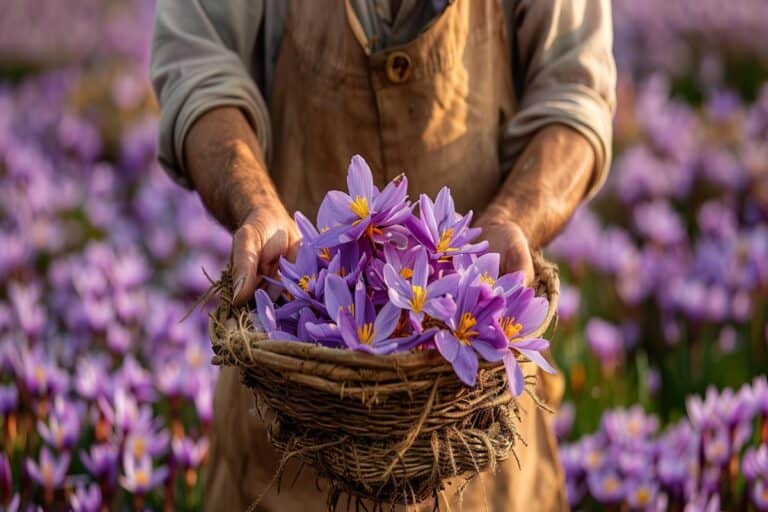Saffron, the gold of spices, the prized thread in Indian cuisine, and one of the most expensive crops on the planet, sells at ₹2,00,000 to ₹5,00,000 per kg. Traditionally, saffron has been geographically restricted, thriving only in cool-weather regions like Kashmir.
But what if saffron could be cultivated outside Kashmir? What if it could be grown indoors, in a controlled environment, even in a tropical region like Kerala?
That’s exactly what LNS AgriTech is doing.
Founded in 2024 by Seshadri Shivakumar, this Wayanad-based agritech startup is pioneering India’s first indoor saffron farm.
And the journey? It wasn’t easy. 🚀
From Civil Engineer to Indoor Farmer: How It All Started
Seshadri spent over a decade in civil engineering until he decided he wanted something more. Farming had always fascinated him, and saffron being rare, lucrative, and challenging to grow caught his interest.
The problem? Kerala’s hot, humid climate was completely unsuitable for saffron, which needs cold temperatures, controlled humidity, and precise CO₂ levels.
Instead of giving up, Seshadri engineered a solution.
Building a Saffron Farm from Scratch Inside a Cold Room
Step 1️⃣: He converted a cold storage room, typically used for food preservation, into a high-tech saffron cultivation chamber.
Step 2️⃣: Installed refrigeration units to mimic Kashmir’s temperature fluctuations from 1°C to 27°C, depending on saffron’s growth stage.
Step 3️⃣: Used aeroponics, eliminating soil to boost disease resistance and optimize planting density.
Step 4️⃣: Integrated grow lights to stimulate flowering, replicating saffron’s natural conditions.
What began as an idea became a fully operational indoor farm and soon enough, LNS AgriTech was harvesting saffron in Kerala.
Why Indoor Saffron Farming Is a Game-Changer
- Space Efficiency: Traditional open-field saffron farms plant 20–30 bulbs per square meter. With aeroponics, Seshadri fits 200–300 bulbs per square meters 10x increase in productivity.
- No Climate Dependence: Forget geography. Indoor farming allows saffron cultivation anywhere, breaking regional limitations.
- Higher Yield: Conventional farms produce 0.5–2 grams of saffron per square meter. LNS AgriTech’s controlled environment boosts that to 4–5 grams per square meter.
- Vertical Farming Potential: Stacking multiple layers further multiplies production, making indoor saffron even more profitable.
And let’s not forget, India imports 70–80% of its saffron, mostly from Iran, because domestic production is too low.
If indoor farming scales up, LNS AgriTech could bridge the gap, reducing imports and giving Indian farmers a high-value crop that isn’t restricted by geography.

The Investment & Challenges Behind the Success
- 💰 Initial investment: ₹10–12 lakh: Setting up a cold room from scratch wasn’t cheap, but Seshadri knew it was worth it.
- 💰 Operating costs: ₹13 lakh: Spent on six months of development, including equipment, research, and infrastructure.
- ⚡ Technical roadblocks: Saffron farming is highly precise, demanding the right light cycles, temperature shifts, and CO₂ balance.
The Future of Indoor Saffron Farming in India
Scaling production: Expanding beyond Wayanad, making indoor saffron accessible to more farmers.
- Branded retail sales: Selling directly in India’s retail market, rather than depending on middlemen.
- Reducing imports: Creating domestic supply chains for India’s high demand for saffron.
- Advancing controlled-environment agriculture: LNS AgriTech isn’t just about saffron, it’s about proving that high-value crops can thrive beyond their traditional habitats.
Final Thoughts: Why LNS AgriTech’s Innovation Matters
Indoor saffron farming isn’t just another startup idea it’s a revolution in Indian agriculture.
- It challenges traditional farming limits.
- It enables high-value crops to grow in non-traditional environments.
- It boosts yield while saving land and resources.
- It opens new opportunities for farmers beyond regional constraints.
By engineering the perfect microclimate, LNS AgriTech is proving that saffron can thrive in Kerala and if that’s possible, what’s next?
From controlled-environment farming to new-age agritech solutions, the possibilities are endless. And if Seshadri’s innovation is any indication, this is just the beginning. 🚀🌍




